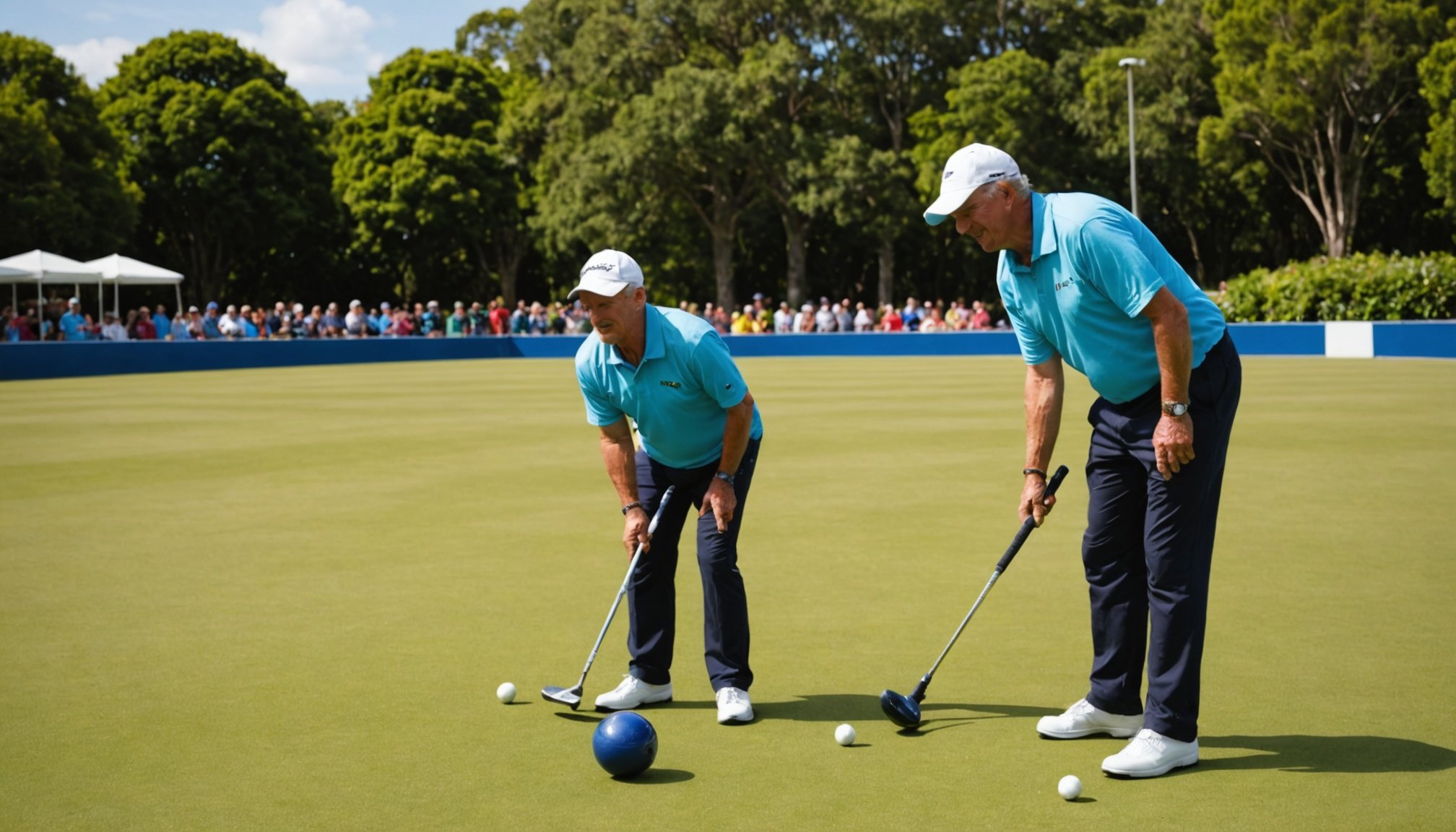Ultimate Guide to Caring for Lawn Bowls Gear: Tips for Peak Performance
Understanding Your Bowling Green: The Foundation of Lawn Bowls
When it comes to lawn bowls, the condition of the bowling green is paramount. Whether you’re a seasoned player or just starting out, understanding and maintaining your green is crucial for high performance and an enjoyable game. Here’s a deep dive into what makes a bowling green tick and how to keep it in perfect condition.
Natural Grass vs. Artificial Turf
One of the first decisions you might face is whether to opt for natural grass or artificial turf. Here are some key points to consider:
Additional reading : Boost Your Table Tennis Game: Essential Exercises to Enhance Agility
Natural Grass:
- Pros:
- Provides a traditional and authentic playing experience.
- Can be more environmentally friendly if properly maintained.
- Offers better drainage and cooling properties.
- Cons:
- Requires regular maintenance, including watering, mowing, and fertilizing.
- Can be susceptible to weather conditions and diseases.
- May develop dry patches and thatch layers if not properly cared for.
Artificial Turf:
Also to see : Ultimate Post-Polo Recovery Strategies: Maximizing Athletic Performance after Competition
- Pros:
- Low maintenance requirements; no need for watering or mowing.
- Consistent playing surface regardless of weather conditions.
- Durable and can withstand heavy use.
- Cons:
- Higher initial cost compared to natural grass.
- Can be hot in direct sunlight and may require additional cooling measures.
- May not offer the same aesthetic appeal as natural grass.
| | Natural Grass | Artificial Turf |
|
|-------------------------|
|
| Maintenance | High | Low |
| Cost | Lower initial cost | Higher initial cost |
| Weather Impact | Susceptible | Consistent |
| Aesthetic | Traditional look | Less natural look |
| Durability | Less durable | More durable |
Assessing and Maintaining Your Bowling Green
To ensure your bowling green remains in top condition, regular assessment and maintenance are essential.
Step-by-Step Assessment
Before you start any maintenance, it’s crucial to understand what’s going on beneath the surface. Here’s how you can do it:
- Take a Deep Profile Sample:
- Use a soil sampler to take a deep profile sample (deeper than 150mm/6″) to see the cross-section of your green. This will help you identify the depth of the thatch layer, any distinct layers, and any hard, compacted pans.
- Analyze the Sample:
- Note the moisture levels, any funny smells, and the overall condition of the soil. Compare samples from different areas of the green to identify any variations.
- Identify Problems:
- Look for signs of dry patch, thatch buildup, or compacted layers. These issues can significantly affect the performance of your green.
Maintenance Tips
Here are some key maintenance tips to keep your bowling green in perfect condition:
-
Watering:
-
Ensure consistent moisture levels. Overwatering can lead to thatch buildup and other issues, while underwatering can cause dry patches.
-
Mowing:
-
Maintain a consistent height. For fine turf, this is typically between 4-6 mm. Regular mowing helps in preventing thatch buildup and promotes healthy growth.
-
Fertilizing:
-
Use a balanced fertilizer to promote healthy grass growth. Avoid overfertilizing, as this can lead to weak and susceptible grass.
-
Scarifying:
-
Scarify your green periodically to remove thatch and dead grass. The frequency depends on the thatch depth and the condition of your green. For example, if you have a high thatch layer, you may need to scarify more frequently.
-
Aeration:
-
Aerating your green helps in improving drainage and reducing soil compaction. This can be done using a fork or an aerator machine.
### Maintenance Schedule
- **Weekly:**
- Mowing
- Watering
- Quick inspection for any issues
- **Monthly:**
- Fertilizing
- Edging
- **Quarterly:**
- Scarifying (if necessary)
- Aeration
- **Annually:**
- Deep profile sampling and analysis
- Major repairs or renovations
Specialized Care for Common Issues
Every bowling green faces unique challenges. Here are some specialized care tips for common issues:
Dry Patch
Dry patch is a common issue that can significantly affect the performance of your green. Here’s how to address it:
-
Identification:
-
Look for areas that are powdery dry and crumbly. These areas often fall apart when sampled.
-
Treatment:
-
Improve drainage by aerating the affected area.
-
Apply a balanced fertilizer to promote healthy growth.
-
Ensure consistent watering, but avoid overwatering.
Thatch Buildup
Thatch buildup can lead to a spongy surface and poor drainage. Here’s how to manage it:
-
Identification:
-
Take a deep profile sample to measure the thatch layer depth.
-
Treatment:
-
Scarify the green to remove the thatch layer.
-
Improve aeration and drainage to prevent future buildup.
Synthetic and Artificial Turf Care
While artificial turf requires less maintenance than natural grass, it still needs regular care to ensure peak performance.
Cleaning
-
Regular Sweeping:
-
Use a broom or a mechanical sweeper to remove debris and dirt from the surface.
-
Deep Cleaning:
-
Use a pressure washer to deep clean the turf periodically. This helps in removing embedded dirt and maintaining the turf’s texture.
Infill Maintenance
-
Top-Dressing:
-
Apply infill materials like sand or rubber crumbs to maintain the turf’s stability and cushioning.
-
Leveling:
-
Ensure the infill is evenly distributed and the surface is level to prevent uneven play.
Community and Club Involvement
Maintaining a bowling green is often a community effort, especially in club settings.
Working with Your Greenkeeper
-
Communication:
-
Regularly communicate with your greenkeeper to understand the maintenance schedule and any issues that arise.
-
Training:
-
If you’re taking over the role of a greenkeeper, seek advice from experienced professionals. For example, understanding the right frequency for scarifying is crucial and can be guided by the thatch depth and overall condition of the green.
Community Events and Education
-
Workshops and Seminars:
-
Organize workshops or seminars to educate members on the best practices for maintaining the bowling green.
-
Volunteer Days:
-
Host volunteer days where members can come together to perform maintenance tasks. This not only helps in distributing the workload but also fosters a sense of community.
Caring for your lawn bowls gear, particularly the bowling green, is a multifaceted task that requires regular assessment, maintenance, and community involvement. Whether you’re dealing with natural grass or artificial turf, understanding the unique needs of your surface is key to ensuring peak performance and a enjoyable game.
As John from Bowls Central advises, “The best way I know of starting this is to have a look at what’s going on under the turf and you can get a good idea of this by taking a deep profile sample.” This proactive approach, combined with the right maintenance tips and community support, will help you achieve the perfect bowl every time.
So, the next time you step onto the green, remember that it’s not just about the game; it’s about the care and dedication that goes into maintaining this beautiful surface. With the right care, your bowling green will be the envy of every club and a testament to your commitment to the sport.






